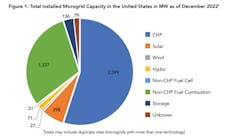State of Play: Strategies for achieving the Clean Energy On-site Power Future
An in-depth snapshot of the past, present and future of U.S. microgrid goals reveals significant contrasts in how the energy transition happens and what distributed energy resources look like around the country.
For one revelation, the American microgrid sector still resembles the old grid with more fossil fuel power backing it up than not. The carbon-heavier aspect of the microgrid mix will change over time but may move more slowly in the U.S. than elsewhere due to the political resistance of state-by-state regulatory models and attitudes.
The new report by the combined contributions of the National Association of Regulatory Utility Commissioners (NARUC) and the National Association of State Energy Officials (NASEO), “Clean Energy Microgrids,” offers insights and considerations for public entities weighing the benefits and options of microgrids to increase resiliency and sustainability.
Many organizations, municipalities and companies have aggressive net zero goals for the near term. Reaching the summits of decarbonization will require heavy lifting and major changes in the ways things are done.
See the full Clean Energy Microgrids report by NARUC and NASEO
Today, taking stock of U.S. federal data, it’s revealing that most of the many hundreds of true microgrids—as distinct from non-controlled distributed energy resources—are mainly powered by fossil fuel resources, particular natural gas and diesel generators, according to the NARUC and NASEO report. Most true microgrids are combined heat and power (CHP) plants totaling close to 2.4 GW (2,400 MW) energizing college campuses, industrial plants and mission-critical facilities such as health care and military operations. Figure 1
Non-CHP generation makes up only about 30 percent of microgrid generation resources. Solar, wind and hydro account for only about 10 percent of that, although solar and battery storage combinations are growing exponentially across the U.S., the NARUC-NASEO study shows.
“Fossil fuels make up about 80 percent of microgrid generation resources, which is higher than the 60 percent of fossil fuels powering the (grid-scale) U.S. electricity sector,” the report reads. “However, analysts predict that by 2025 wind, solar, hydropower and energy storage will represent 35 percent of annual microgrid capacity.”
The anticipated and exponential growth is because renewables such as solar and wind consistently are falling in price and making the economical argument easier for clean energy microgrids. Another selling point is on-site fuel security, considering that diesel and natural gas must be transported by either truck or pipeline and cannot be maintained on-site for lengthy periods without some degradation or loss of the product.
“The risk of fuel scarcity is particularly high for communities in remote and rural areas where diesel generators are relied on for back-up power,” the NARUC-NASEO study pointed out, citing earlier reports by the federal government. Meanwhile, a global comparison of emissions showed that a review of 13 diesel generators indicated a carbon dioxide emission factor which would be greatly reduced with cleaner, renewable resources. “As a result of switching to the solar PV-based microgrid, more than 375,000 liters of diesel were not needed, which led to a reduction of more than 975,000 kilograms of carbon dioxide annually.”
Hedging to avoid the huge Transmission Investment Headache
Mission-critical, commercial and industrial facilities decision makers are taking note. The Biden-era U.S. Army administration has released a long-term climate strategy mandating a microgrid at every installation by 2035. Meanwhile, many remote Native tribes, health care centers and manufacturing sites are accelerating on-site power conversions to bolster resiliency and sustainability in the face of increasingly extreme weather.
NARUC and NASEO acknowledge several key barriers to widespread microgrid adoption, from certain takes on cost-benefit analysis, energy density concerns and, last but not least, the wildly divergent political frameworks involved in 50 U.S. states. Yet, even the cold, hard truth that renewable energy has a lower capacity factor than conventional fuels is countered by scalable cost reductions potentially achievable on a holistic level.
“Although studies have found that to displace 1 kWh of fossil fuel generation (takes) more than 10 kWh of renewable generation…this is in large part due to variableness of renewable energy and the fact that (most utility-scale, off-site) renewable generation is often constructed far from the distribution site, leading to line losses as electricity travels across long distances,” the NARUC-NASEO report reads.
“Microgrids provide local generation and thus eliminate this power loss, as well as alleviate grid congestion,” the report added. “This minimizes the need for expensive, high-capacity transmission lines.”
A 2020 Princeton University study forecasted that expanding the utility grid would cost about $2.4 trillion to enable the transmission and distribution system to accommodate growth in renewables, electric vehicle charging and home electrification. That figure seems even more politically challenging considering the U.S. has two parties fighting intensely over less expensive points of disagreement including recently overturned student loan forgiveness policies totaling maybe $500 million or so.
A microgrid, which could vary in costs from $250,000 to $4 million or more depending on the mission and scale, could provide a viable and cost-effective alternative to purely utility-scale renewable energy macro systems. Pardon the amateur calculation here, but 500 microgrids at an average $2 million each would still cost less than half of Princeton-estimated utility grid expenditures need on the T&D systems to reach net zero goals.
The NARUC-NASEO report partially advocates for potential funding mechanisms such as microgrid tariffs, although those would have to take into account cost-shifting and rate cases impacting non-participating customers. Beyond that, microgrid advocates say the financial argument is strengthened because of case studies showing businesses able to keep operating even in the event of major climate disasters.
“For example, during Winter Storm Uri in early winter 2022, more than 100 grocery stores in Texas were able to continue to operate due to their gas-powered microgrid, not only saving costs by preventing food spoilage but also ensuring food security for the communities served,” the NARUC-NASEO report reads.
And yes that’s natural gas, a fossil fuel but one that produces lower emissions than diesel and certainly coal-fired utility power plants.
“Natural gas provides firm generation, which is critical during grid outages for customers requiring a continuous power supply,” the report noted. “To decrease emissions while still providing resilience benefits, several microgrids use biofuels.”
State energy offices and regulators around the U.S. are well-advised to consider microgrids as a means of joining energy security and sustainability goals, the NARUC-NASEO study recommended.
Worldwide, meanwhile, an equally new report from consulting giant Accenture and the World Economic Forum pointed out that global energy transition challenges are formidable, too, despite consensus on the impacts of climate change. Only about one-fifth of nations are actively balancing the imperatives of those energy transition goals, that report pointed out.
Some of the other nations actively aiming for distributed energy resource and/or microgrid solutions include Japan, Brazil, China, India and South Africa.
About the Author
Rod Walton, Microgrid Knowledge Managing Editor
Managing Editor
For Microgrid Knowledge editorial inquiries, please contact Managing Editor Rod Walton at [email protected].
I’ve spent the last 15 years covering the energy industry as a newspaper and trade journalist. I was an energy writer and business editor at the Tulsa World before moving to business-to-business media at PennWell Publishing, which later became Clarion Events, where I covered the electric power industry. I joined Endeavor Business Media in November 2021 to help launch EnergyTech, one of the company’s newest media brands. I joined Microgrid Knowledge in July 2023.
I earned my Bachelors degree in journalism from the University of Oklahoma. My career stops include the Moore American, Bartlesville Examiner-Enterprise, Wagoner Tribune and Tulsa World, all in Oklahoma . I have been married to Laura for the past 33-plus years and we have four children and one adorable granddaughter. We want the energy transition to make their lives better in the future.
Microgrid Knowledge and EnergyTech are focused on the mission critical and large-scale energy users and their sustainability and resiliency goals. These include the commercial and industrial sectors, as well as the military, universities, data centers and microgrids. The C&I sectors together account for close to 30 percent of greenhouse gas emissions in the U.S.
Many large-scale energy users such as Fortune 500 companies, and mission-critical users such as military bases, universities, healthcare facilities, public safety and data centers, shifting their energy priorities to reach net-zero carbon goals within the coming decades. These include plans for renewable energy power purchase agreements, but also on-site resiliency projects such as microgrids, combined heat and power, rooftop solar, energy storage, digitalization and building efficiency upgrades.


